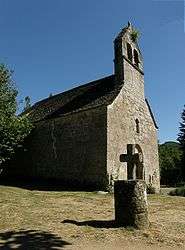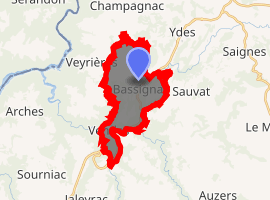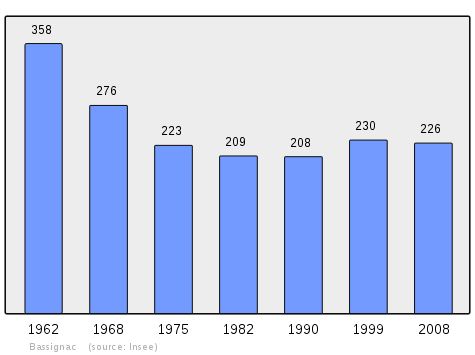Bassignac
Bassignac is a commune in the Cantal department in the Auvergne region of south-central France.[2]
Bassignac | |
|---|---|
 The Romanesque chapel of Saint-Jacques, in the hamlet of Vendes, in Bassignac | |
Location of Bassignac 
| |
 Bassignac  Bassignac | |
| Coordinates: 45°19′18″N 2°24′24″E | |
| Country | France |
| Region | Auvergne-Rhône-Alpes |
| Department | Cantal |
| Arrondissement | Mauriac |
| Canton | Ydes |
| Intercommunality | Sumène Artense |
| Government | |
| • Mayor (2008–2014) | Marc Maisonneuve |
| Area 1 | 11.95 km2 (4.61 sq mi) |
| Population (2017-01-01)[1] | 231 |
| • Density | 19/km2 (50/sq mi) |
| Time zone | UTC+01:00 (CET) |
| • Summer (DST) | UTC+02:00 (CEST) |
| INSEE/Postal code | 15019 /15240 |
| Elevation | 359–671 m (1,178–2,201 ft) (avg. 412 m or 1,352 ft) |
| 1 French Land Register data, which excludes lakes, ponds, glaciers > 1 km2 (0.386 sq mi or 247 acres) and river estuaries. | |
Geography
Bassignac is located some 35 km north-east of Tulle and 10 km south by south-west of Bort-les-Orgues. Access to the commune is by the D922 road from Ydes in the north which passes through the length of the commune and the village and continues south to Mauriac. The D12 comes from Veyrières in the west and goes down the western border joining the D922 at Vendes. The D512 branches off the D12 and passes through Parensol continuing north to join the D922 south of Ydes. Apart from the village there are the hamlets of Le Fau, Le Marlat, Parensol, Montgroux, Vendes, Brousse, and Champleix. The commune is mixed forest and farmland.[3][4]
Vendes is the largest village in the commune with 60 inhabitants in winter and about 100 in summer and is dominated by the old Sumène viaduct.[5]
The Sumène river flows through the commune from north to south turning west to form the southern border of the commune and continuing west to join the Dordogne north of Arches. The Ruisseau de la Graille rises in the centre of the commune and flows north then south to join the Sumène. The Ruisseau de Rouillade flows south forming the eastern border of the commune before joining the Sumène near the centre of the commune.[3][4]
History
In the 10th century the hamlet of Vendes was the property of Artaud de Charlus. Charlus was a promontory some 4 km north of Vendes and had a fortified chateau on top. There are no remains except a view across the mountains of Auvergne. The Lévis-Charlus family was a noble family.[5]
Bassignac appears as Baßignac on the 1750 Cassini Map[6] and as Bassignac on the 1790 version.[7]
There was a railway running through the commune with the second longest viaduct in Cantal at 367m and a height of 46m. The viaduct and railway were opened in 1893 as part of the SNCF line from Paris-Austerlitz-Aurillac. The line closed on 3 July 1994 and the viaduct was abandoned.[5]
Demography
In 2010 the commune had 224 inhabitants. The evolution of the number of inhabitants is known from the population censuses conducted in the commune since 1793. From the 21st century, a census of communes with fewer than 10,000 inhabitants is held every five years, unlike larger communes that have a sample survey every year.[Note 1]
| 1793 | 1800 | 1806 | 1821 | 1831 | 1836 | 1841 | 1846 | 1851 |
|---|---|---|---|---|---|---|---|---|
| 539 | 545 | 570 | 520 | 585 | 535 | 512 | 600 | 587 |
| 1856 | 1861 | 1866 | 1872 | 1876 | 1881 | 1886 | 1891 | 1896 |
|---|---|---|---|---|---|---|---|---|
| 584 | 515 | 531 | 455 | 512 | 508 | 485 | 1,260 | 635 |
| 1901 | 1906 | 1911 | 1921 | 1926 | 1931 | 1936 | 1946 | 1954 |
|---|---|---|---|---|---|---|---|---|
| 636 | 639 | 540 | 567 | 562 | 637 | 461 | 524 | 422 |
| 1962 | 1968 | 1975 | 1982 | 1990 | 1999 | 2006 | 2010 | - |
|---|---|---|---|---|---|---|---|---|
| 358 | 276 | 223 | 209 | 208 | 230 | 224 | - |

Education
The commune has a public primary school at Vendes.[9]
Associations
- Association 3V - The espavents, Vendes Viaduct Village: Association to safeguard the Sumène viaduct and the festival of scarecrows.[5]
Culture and heritage
Civil heritage
The commune has many buildings and sites that are registered as historical monuments:
- The Sumène Viaduct (1893)


- A Priory House (1746)

- The Chateau Park

- Coal Mining Industrial Buildings (19th century)

- Houses and Farms (17th-20th century)

- A Flour Mill at Vendes (1799)

- A City of Miners at Champleix (20th century)

- A Farmhouse at Lavaurs (1865)

- A Mercahnt's House at Lachamp (1868)

- A Farmhouse at Le Fau (1769)

- A Farmhouse at La Riagaire (1799)

- A Farmhouse at Montgroux (1830)

- A Farmhouse at Emprades (16th century)

- The Chateau du Rieu Farmhouse at Le Rieu (1755)

- A Road Bridge at Vendes (18th century)

- A Wheelwright and Blacksmith's House at Vendes (18th century)

- A House at Vendes (1746)

- A Chateau at Vendes (1780)

- A Chateau (15th century)

Religious heritage
The commune has several religious buildings and sites that are registered as historical monuments:
- The Church of Vendes (11th century)

- Monumental Crosses (19th-20th century)

- The Benedictine Priory of Saint Jacques (1778)

- The Parish Church of Sainte-Marie and Sainte-Radegonde (12th century)

- A Stained glass window: God the Father blessing (15th century)

- A Stained glass window: Christ blessing (15th century)

- An ex-voto Painting: The Crucifixion (1633)

- 4 Capitals and 2 bases (12th century)

- The Furniture in the Church

- A Candle Mould (19th century)

- A Chalice (18th century)

- A Statue: Saint Radegonde of Poitiers (17th century)

- A Painting: The Adoration of the citizens (19th century)

- A Painting: Saint Radegonde of Poitiers (19th century)

- A Painting: The Crucifixion (1633)

- 2 Windows: Christ blessing and God the Father (16th century)

- A Stained glass window: God the Father blessing (15th century)
See also
Notes and references
Notes
- At the beginning of the 21st century, the methods of identification have been modified by Law No. 2002-276 of 27 February 2002 Archived 6 March 2016 at the Wayback Machine, the so-called "law of local democracy" and in particular Title V "census operations" allows, after a transitional period running from 2004 to 2008, the annual publication of the legal population of the different French administrative districts. For communes with a population greater than 10,000 inhabitants, a sample survey is conducted annually and the entire territory of these communes is taken into account at the end of the period of five years. The first "legal population" after 1999 under this new law came into force on 1 January 2009 and was based on the census of 2006.
References
- "Populations légales 2017". INSEE. Retrieved 6 January 2020.
- Bassignac on Lion1906
- Bassignac on Google Maps
- Bassignac on the Géoportail from National Geographic Institute (IGN) website (in French)
- 3V The Espavents website (in French)
- Baßignac on the 1750 Cassini Map
- Bassignac on the 1790 Cassini Map
- List of Mayors of France (in French)
- Schools in Bassignac (in French)
- Ministry of Culture, Mérimée PA15000034 PA15000036 PA15000119 IA15000125 Sumène Viaduct (in French)
- Ministry of Culture, Palissy PM15000753 Interior decor of the Viaduct (in French)
- Ministry of Culture, Mérimée PA15000013 Priory House (in French)
- Ministry of Culture, Mérimée IA15000280 Chateau Park (in French)
- Ministry of Culture, Mérimée IA15000402 Coal Mining Industrial Buildings

- Ministry of Culture, Mérimée IA15000390 Houses and Farms (in French)
- Ministry of Culture, Mérimée IA15000135 Flour Mill

- Ministry of Culture, Mérimée IA15000133 City of Miners

- Ministry of Culture, Mérimée IA15000132 Farmhouse at Lavaurs

- Ministry of Culture, Mérimée IA15000131 Merchant's House at Lachamp

- Ministry of Culture, Mérimée IA15000130 Farmhouse at Le Fau

- Ministry of Culture, Mérimée IA15000129 Farmhouse at La Riagaire

- Ministry of Culture, Mérimée IA15000128 Farmhouse at Montgroux

- Ministry of Culture, Mérimée IA15000127 Farmhouse at La Riagaire (in French)
- Ministry of Culture, Mérimée IA15000129 Chateau du Rieu Farmhouse

- Ministry of Culture, Mérimée IA15000124 Road Bridge at Vendes

- Ministry of Culture, Mérimée IA15000128 Wheelwright and Blacksmith's House

- Ministry of Culture, Mérimée IA15000122 House at Vendes

- Ministry of Culture, Mérimée IA15000121 Chateau at Vendes

- Ministry of Culture, Mérimée IA15000118 Chateau

- Ministry of Culture, Mérimée PA00093473 Church of Vendes (in French)
- Ministry of Culture, Mérimée IA15000134 Monumental Crosses (in French)
- Ministry of Culture, Mérimée IA15000120 Benedictine Priory of Saint Jacques

- Ministry of Culture, Palissy IM15000054 PM15000055 Furniture in the Priory

- Ministry of Culture, Palissy IM15000053 Group Sculpture: Education of the Virgin

- Ministry of Culture, Palissy IM15000052 Statuette: Saint Marguerite of Antioch

- Ministry of Culture, Palissy IM15000051 Statuette: Saint Barbe

- Ministry of Culture, Palissy IM15000050 2 Statuettes: Saint Jacques and Saint Joseph

- Ministry of Culture, Palissy IM15000049 Stoup

- Ministry of Culture, Mérimée IA15000117 Parish Church of Sainte-Marie and Sainte-Radegonde

- Ministry of Culture, Palissy IM15002033 Stained glass window: God the Father blessing

- Ministry of Culture, Palissy IM15002032 Stained glass window: Christ blessing

- Ministry of Culture, Palissy IM15000110 Ex-voto Painting: The Crucifixion (in French)
- Ministry of Culture, Palissy IM15000195 4 Capitals and 2 bases (in French)
- Ministry of Culture, Palissy IM15000047IM15000048 Funiture in the Church (in French)
- Ministry of Culture, Palissy IM15000046 Candle Mould

- Ministry of Culture, Palissy IM15000045 Chalice

- Ministry of Culture, Palissy IM15000044 Statue: Saint Radegonde of Poitiers

- Ministry of Culture, Palissy IM15000043 Painting: The Adoration of the citizens

- Ministry of Culture, Palissy IM15000042 Painting: Saint Radegonde of Poitiers

- Ministry of Culture, Palissy IM15000041 Painting: The Crucifixion

- Ministry of Culture, Palissy IM15000040 2 Windows: Christ blessing and God the Father

| Wikimedia Commons has media related to Bassignac. |